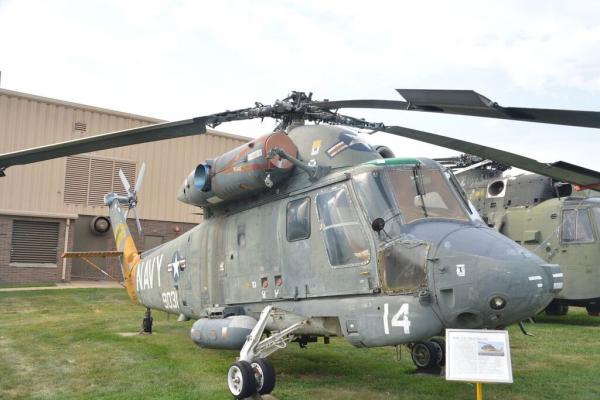
Kaman Aircraft Corporation
First Flight: July 2, 1959
Two seats
In 1956, the U.S. Navy announced a design competition for a new, high‑speed, long‑range multipurpose helicopter. The Kaman K-20 won the contest, but trials were lengthy, partly on account of the number of innovations made to the aircraft. The first models, designated UH‑2A Seasprite, only went into service at the end of 1962. Eighty‑eight UH‑2As were built, and the sea‑gray aircraft with its fluorescent markings became a familiar sight on American aircraft carriers. Its successor, the UH‑213, was virtually identical.
The Seasprite is a conventional type of turbine‑powered helicopter, with a four‑blade main rotor and three blade anti‑torque rotor. It replaced earlier piston‑engined helicopters for a range of duties that included reconnaissance, supply, carrier “plane guard,” communications, ship‑to-shore transport, and casualty evacuation, although its principal role is that of search and rescue. Flown by a crew of 2, it could accommodate up to 11 passengers or 4 stretchers in the cabin. It had a watertight body for landings at sea. In flight, the wheeled undercarriage was fully retractable, emphasizing the aircraft’s unusually clean lines. First UH‑2A deliveries were made to the U.S. Navy’s squadron HU‑2 in December 1962, and the type first went to sea aboard the U.S.S. Independence in June 1963. The UH‑2B followed suit, on the U.S.S. Albany, two months later, and both types were employed extensively in the Pacific and southeast Asia.
Originally single-engined, the Seasprite was redesigned in 1964 with twin GET58‑GE‑8 turbines in pods on either side of the rotor pylon. This gave it better performance and twin‑engined reliability. The conversion was so successful that over 100 UH‑2A’s and UH‑2B’s were subsequently converted into UH‑2C’s; almost as many became HH‑2C’s and HH‑2D’s. The HH-2C was an armed and protected version. The HH‑2D models were obtained by converting 31 single‑engine helicopters to the standard of the HH‑2C, but without the weapons and protection.
The U.S. Navy then considered the possibility of using the Seasprite for anti-submarine warfare, which gave rise to the SH‑2D for the LAMPS (Light Airborne Multipurpose System) program. It was similar to the HH‑2D but had a search radar in a cylindrical radome beneath the cabin, MAD gear, and sonobuoys. A few aircraft were also tested with dipping sonar. The launchable weapons consisted of two Mk.46 torpedoes or anti-ship missiles. Twenty HH‑2D’s were transformed into the SH‑21 ASW variant, while 194 of the. SH‑2F version, which is still in service, have been built. These differed from the SH‑2D in having a new rotor and stronger landing gear.
| Aircraft Specifications | |
|---|---|
| Rotor Diameter | 44 ft |
| Fuselage Length | 40 ft 4 in |
| Maximum Speed | 165 mph |
| Height | 15 ft 6 in |
| Empty Weight | 7,055 lbs |
| Gross Weight | 12,808 |
| Engine | GE T58 8F 1350 hp |
| Source | Loan from the National Naval Aviation Museum |